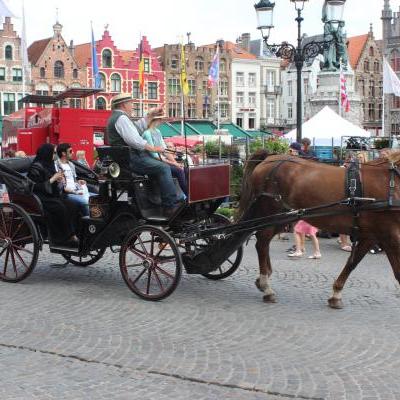Farrier (Hoefsmid)
Information on this skill...
A farrier is a craftsman who provides ungulates, such as horses, ponies and donkeys, with horseshoes. The main reason for applying horseshoes is to prevent wear and tear on the hooves. It is the farrier who specializes in maintaining and promoting the correct hoof position, so that hoof problems are prevented. In the past, it was quite normal for a local village blacksmith to supply horses with new horseshoes. Nowadays, there are specialized farriers, who work on location to provide horses with new horseshoes. The profession of farrier is not a protected profession, and everyone can call themselves a farrier. Despite the fact that everyone can call themselves a farrier, it is very important as a farrier to follow a good education because you work with animals. The profession of farrier falls under the so-called specialized animal care. As a farrier, it is important that you have sufficient knowledge of the anatomy of ungulates because the profession involves more than just shoeing ungulates. A farrier nowadays works in most cases with horseshoes that are factory made, and adjusts them as necessary. The application of hooves is also called the fogging of horseshoes. A horseshoe is a metal or cast iron protection for the hooves of an ungulate. A farrier must also have knowledge of the anatomy of the hoof and of the horse, and must be able to recognize possible health problems and possibly prevent or remedy them. In short, we can best describe the work of a farrier as hoof care. Hoof care also involves scraping out and greasing hooves, but this work does not have to be carried out by a special farrier. Trimming hooves will generally be done by a farrier.
A farrier is therefore specialized in fogging and trimming the hooves of horses and ponies. In the past, a farrier was a blacksmith, who also performed other work. Nowadays, a farrier can no longer be considered a blacksmith because a farrier no longer forges horseshoes. The forging of horseshoes involves the hot firing of a rod of iron and the processing of the iron into a horseshoe. Farriers nowadays use factory irons, which only need to be adjusted. In the past, farriers mainly worked for farmers, who used workhorses to work the land. Nowadays, a farrier in many cases has to deal with riding horses. A farrier can apply different horseshoes to horses and ponies. The type of horseshoe used depends on the activity for which a horse or pony is used. Working as a farrier can be regarded as physically demanding work. This is the case because a farrier works at different locations, where the working conditions are sometimes not ideal. As described earlier, a farrier is not only responsible for fogging and trimming ungulates. A farrier is also responsible for preventing hoof diseases and checking for abnormalities of the hooves. As a farrier, you can also work with a veterinarian if you notice certain abnormalities. A traditional farrier can be considered a craftsman.
DISADVANTAGES OF HORSESHOES
Horseshoes don't just have advantages. There are even quite a few disadvantages that can cause damage, such as reduced blood flow to the hoof and the reduced shock absorption of the ungulate. Some other disadvantages are the weakening of the hoof wall, the nail holes, the chance of slipping on asphalt, the weight change and the narrowing of the hoof because it is squeezed together by the horseshoe and the natural growth of the hoof is prevented. But horseshoes do not only have advantages for the owner himself because horseshoes are maintenance-sensitive and relatively expensive.
SOME IMPORTANT TASKS OF THE FARRIER ARE:
- Assessing hooves, herding and care condition;
- Trimming horses;
- Carrying out daily care;
- Carrying out periodic care;
- Assessing hooves, position and gait;
- Trimming a dead foot;
- Removing loose iron.
WHAT DOES A FARRIER DO:
TRAINING TO BECOME A FARRIER
If you want to become a farrier, it is best to follow the Mbo training Farrier (Specialized animal care horse). The training specialized animal care with the specialization horse is an MBO course at level three and will usually take three years. During this training there will be attention for the trimming, forging and fogging of ungulates. But of course there is also a lot of attention for the anatomy of the horse. This training will involve a lot of practical lessons and certainly not only be theoretical. Because you will work as a farrier in many cases as an independent entrepreneur, there is also attention for entrepreneurship, such as keeping an administration, and your commercial skills. There is a Dutch Association of Farriers where more information can be found about training opportunities for the profession of farrier and conditions to be able to use the title Certified European Farrier as a farrier. Accounting is also important as an entrepreneur.
COMPANIES WHERE A FARRIER CAN BE EMPLOYED
Most farriers must be regarded as entrepreneurs who work within their own farriery. As a farrier, you will mainly work for riding schools, riders, horse breeders, veterinary clinics, equestrian companies and veterinary practices. In most cases, a farrier works on location. As described earlier, a farrier can no longer be regarded as a blacksmith, as was the case in the past. The vast majority of farriers nowadays have to be regarded as self-employed.
COMPETENCES FARRIER
The most important competence of a farrier is the professional knowledge of hoof care. In addition, you will have to be physically healthy because working as a farrier is fairly heavy. As a farrier, you not only have to deal with horses but also with the owners. It is therefore important that a farrier has good communication skills. Because most farriers work as entrepreneurs, you must also have general entrepreneurial skills. Networking can also be important as an entrepreneur. Generally important words are motivation, cooperation, vigilance, control, planning, sense of responsibility, energy and critical.
LABOUR MARKET PERSPECTIVE AND CAREER OPPORTUNITIES AS A FARRIER
The labour market perspective as a farrier is reasonable. There are quite a lot of independent entrepreneurs working as farriers, and not all farriers can make ends meet from their work. They therefore combine the work with other tasks in the field of health. The career opportunities as a farrier should be seen in further learning to, for example, an MBO education level four, so that you will have better career opportunities as a farrier. Building a customer base as a new farrier is not always easy and will usually require a lot of perseverance from someone.
TERMS OF EMPLOYMENT AND SALARY FARRIER
Because we assume that you will work as a farrier as an independent entrepreneur, no employment conditions apply to the profession of farrier because as an entrepreneur, you will determine your own employment conditions. There is also no just a salary indication to indicate because this will be highly dependent on the number of assignments that know how to collect as a farrier. A farrier usually does not work by the hour, but with fixed fees for his services. As described earlier, there are quite a lot of farriers who also perform other tasks besides shoeing horses.
The content on this page has been automatically translated from the Dutch language. For this reason, texts and videos on this page may contain small errors.
Lesen Sie diese Informationen auf Hufschmied auf Deutsch.
Lea esta información sobre Herrador en español.
Lees deze informatie over Hoefsmid in het Nederlands.
Mijnzzp.nl


